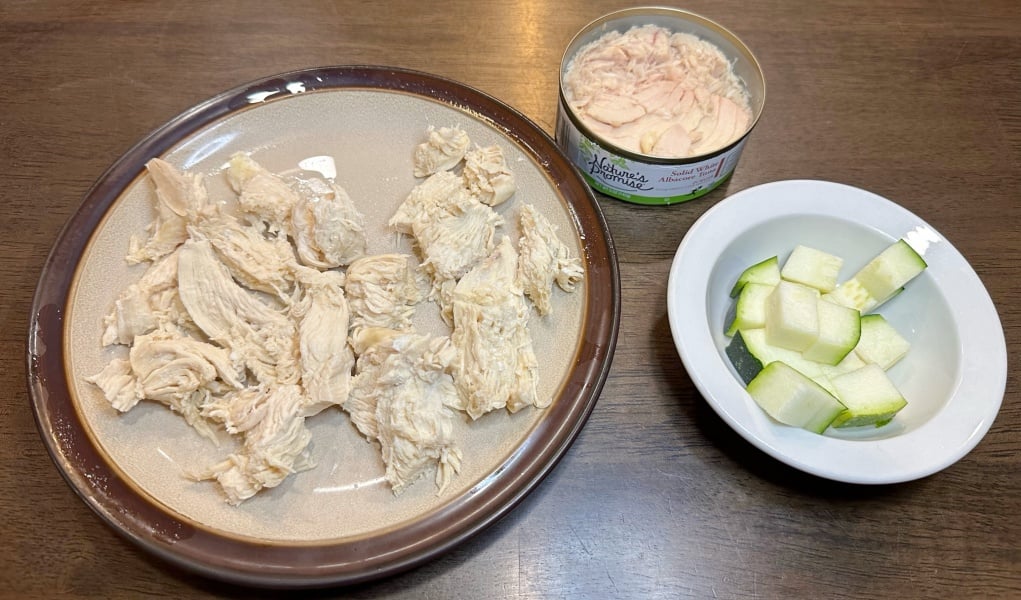Cats are known for being finicky creatures. Senior cats can be especially difficult to feed. This homemade food for senior cats should tempt even the pickiest eaters.
Older cats have a slower metabolism. They may have dental issues or health concerns that make it difficult to eat traditional kibble cat food.
Many issues with senior pets can be helped by a change in diet. Senior cats won't need as many calories as they used to. For these reasons and many more, it is imperative that you discuss any dietary changes with your veterinarian.
Supplements, like glucosamine and chondroitin, are beneficial to include in senior cat food recipes. It may also be helpful to add pre- and probiotics to your older cat's diet.
There are many beneficial supplements that can aid in hip and joint health, digestion, cognitive ability and skin and coat health. Your cat may need assistance in all of these areas, and your vet can help you decide which supplements may be right for your pet.
Homemade Food for Senior Cats

Before you decide to switch your cat's diet (whether he's a senior or not) you need to discuss the change with your veterinarian or a trained feline nutritionist. Trying to make the switch yourself could lead to malnutrition or nutrient toxicity.
This homemade food for senior cats will not be nutritionally balanced for every cat, so be sure to check with your vet about supplements and/or multivitamins that would be beneficial to add to the recipe.
PrintRecipe: Homemade Food for Senior Cats
With just three ingredients, this recipe is a great option for picky older cats or pets with digestive issues. It would also be a ideal for a cat with food allergies.
I used chicken to make this homemade food for senior cats. You could substitute another protein source if your cat is allergic to chicken or just prefers a different option.
- Prep Time: 5 minutes
- Cook Time: 20 minutes
- Total Time: 25 minutes
- Yield: about 3 cups of food 1x
- Category: Cooked Food
- Method: Stovetop
- Cuisine: Cat Food
Ingredients
- 1 cup chicken breast cooked
- 1 can tuna with oil
- 1.5 tbsp zucchini
Instructions
This recipe is incredibly easy to make. First, you'll need to cook the chicken.
I boiled the chicken for my recipe, but you could bake or grill it as well. Just be sure that you don't add any oil or extra ingredients when cooking the meat.
Add the cooked chicken, tuna and zucchini to a food processor. Pulse until the recipe is the consistency of canned cat food.
Once the food is fully cooled, you can serve it to your cat.
Nutrition
- Serving Size: 1/4 cup
- Calories: 45
- Sugar: 0
- Sodium: 15 mg
- Fat: 1.6 g
- Carbohydrates: 0
- Fiber: 0
- Protein: 7.3 g
- Cholesterol: 14 mg
How much to feed: I recommend feeding about 1/3-1/2 cup of food daily. This recommendation is for 2 servings per day.
This is just a guideline.
Typically cats do not overeat, but some cats do. Your cat may not overeat dry kibble, but the enticing whole food ingredients of homemade cat food may cause him to eat more than he should.
How to store: You can store the leftover homemade food for senior cats in an airtight container in the refrigerator for 3-5 days or freeze it in an airtight container for storage of up to 3 months.
Keep in mind that this recipe includes no preservatives, so it won't last nearly as long as commercial cat food.
For More Information
We publish many homemade dog food and treat recipes every month. For more recipes, pet food cooking tips, and advice, see our “Recipes” section. If you're new to the home-cooked pet food subject, I recommend you read more about “How Much To Feed” to understand serving sizes, “What Supplements To Use” to create well-balanced meals, and “How To Store” for tips on simple and easy homemade pet food storing in a fridge or a freezer.













